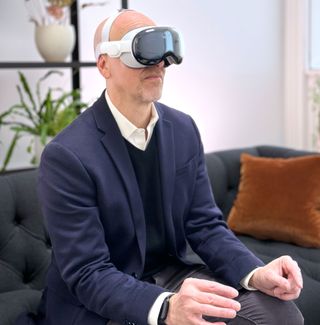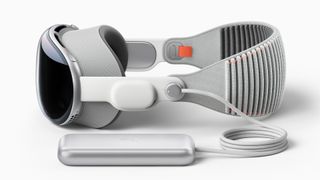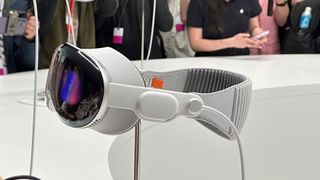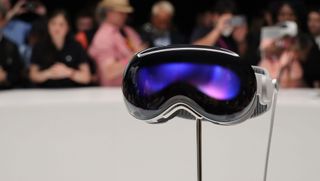Apple Vision Pro is not wireless and this drives some people to distraction
Let’s start with the most basic and striking fact: Apple Vision Pro is not wireless. It has an external battery that I have seen, touched and sat next to. It’s no secret. It shouldn’t be a surprise. However, somehow it generates more interest and controversy than almost any other part of the product that is about to be shipped.
It’s been almost seven months since Apple’s Vision Pro mixed reality headset (which ships on February 2). This includes four hands-on experiences and a significant deep dive into the specifications and uses of the world’s first ‘spatial computer’. Apple has created a remarkable piece of hardware that, despite similarities to other mixed reality and virtual reality headsets I’ve worn over the years, is also unlike any other. I like it and wish it was a lot cheaper.
From the moment I first saw the headset in June at Apple Park, where Apple had placed a dozen of them in a circle and frenzied journalists revolved around them, looking for good photos or videos of the products we couldn’t touch , there was the cable and the battery. I took pictures of it and saw how the rock looked like the aluminum back of an original iPhone (I still don’t think that’s an accident).
Later that same day I took my first Vision Pro test drive. Apple had me sit down and helped me position the cable running from the left side of the headset so it was out of the way. My eyes followed that cable to the battery brick that sat casually on the pillow next to me. When I got up to be “nose to nose” with a dinosaur, someone handed me the battery so I could carry it with me.
During my most recent demo, I stood up again, but this time someone held the battery for me, and for the first time, my arm caught the battery cable as I reached for a virtual object.
I never thought Apple was trying to hide the battery, although I have to admit Apple is doing its best to market it on the sidelines.
Looking forward to this latest test drive, and after spending so much time with Vision Pro, I wondered what I might do or see that was new, but I knew one thing: Apple was finally letting us take pictures while wearing it. That in itself made the trip worth it.
However, the photos I have since shared in posts and on social media were not taken by me. As far as I know, none of the photos of journalists shared online were taken by them. Apple took care of the photography and thus composed the shots. The fact is that none of the photos I’ve seen of various media types wearing and using Vision Pro show the MagSafe style attached wire or battery pack.
Did Apple do this on purpose? Probably. Vision Pro looks better without that cable and the battery lying lifeless next to the wearer on the couch.
Is Apple trying to hide something?
I still don’t think so. The battery is featured in every launch story, mentioned in press and marketing materials, and on the Apple Vision Pro website as one of the items in the box (along with the lens cap, cleaning cloth, Solo Knit Band, Dula Loop Band, charging adapter and USB-C charging cable). Apple is advertising a Belkin Battery Case for Apple Vision Pro ($49.95), an item that will certainly come in handy when you want to be on the go.
Apple is open about how long you can use Vision Pro on battery power (2 hours) and that you can still use the headset while charging the brick.
None of this is to say that Apple isn’t trying to have its cake and eat it too. The Vision Pro, weighing approximately 1 kg, has all the hallmarks of Apple’s iconic design talent. The brushed aluminum body, which virtually merges with the molded glass front, looks and feels like Apple’s most timeless design. It’s the beauty of Jony Ive without Jony Ive (as far as I know, the legendary former Apple designer did not work on this project). The battery is an appendage, a technical decision with undeniable consequences.
Wearables require not only pleasant aesthetics, but also comfort. I would put comfort over good looks and I think most VR designers do too. Meta Quest Pro isn’t a fancy VR headset, but it does a good job of balancing its 1.6-pound weight on the front and back of your head. It, like most modern VR headsets I’ve used, integrates the battery. These types of headsets may be heavier and bulkier than you would like for this reason.
The glasses-like design of Apple Vision Pro, and possibly Apple’s emphasis on using certain materials like aluminum and glass that may weigh more than plastic, while keeping the weight as close to a pound and a half as possible, meant something had to give.
That roughly half-pound battery brick might as well have been attached to the back of the headset, perhaps built into the Solo Knit Band. I bet there are early prototypes that include this. However, Apple did the least Apple thing and kept the battery separate.
Apple’s desire for sleek designs and equally polished marketing is at odds with the nagging fact of the Vision Pro battery. Apple will not run any commercials that focus on the battery, and I’m willing to bet that any commercials that do appear on the radio will briefly feature the battery.
But Apple can’t hide the battery. It’s a fact that was established on day one and while I know Apple has done its best to present the clearest possible image of its new headset, I don’t consider this a bait and switch.
Anyone preparing to spend $3,499 (or more) on a Vision Pro will, one hopes, peruse the website to learn all about it. No one buys a Vision Pro because of the photo of me wearing it. If all you know about the headset is what you learned from seeing those photos and making assumptions based on that, then you’re doing yourself a disservice.
So let me make this as clear as possible. The Apple Vision Pro is a mixed reality headset that requires an external battery and cable. It won’t work without it. I understand this bothers you, especially since Apple requires at least one month’s mortgage payment to own one. None of this makes it a secret or a lie. Apple’s choice becomes your choice. You either buy it and accept the battery, or you don’t and may look for much cheaper battery-integrated options.





